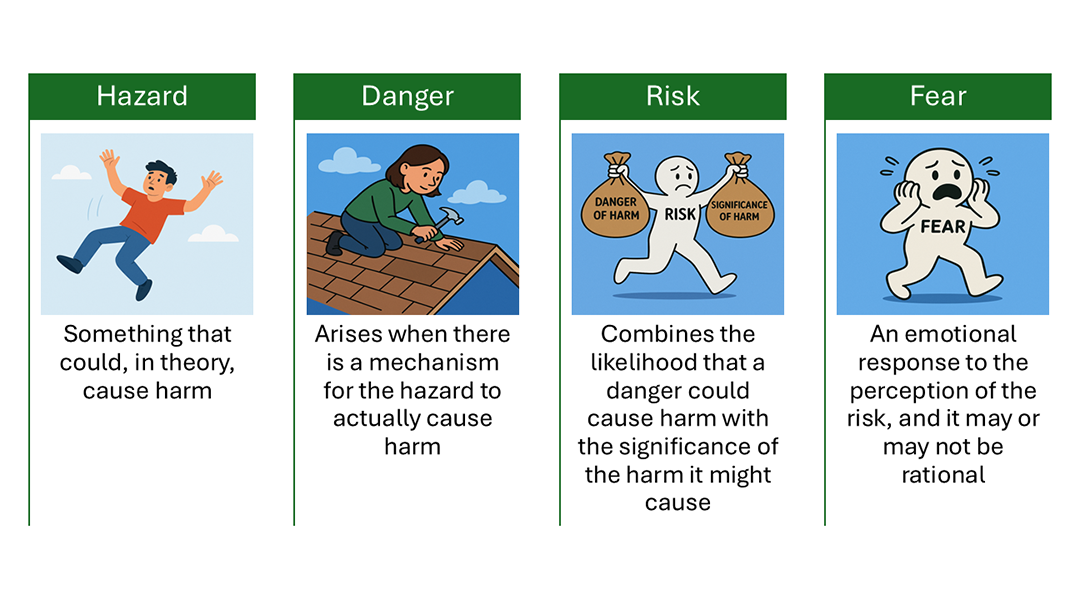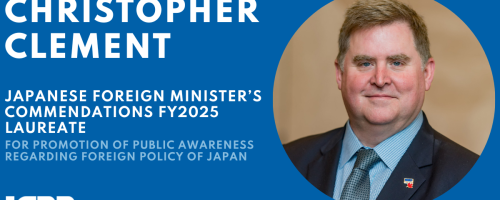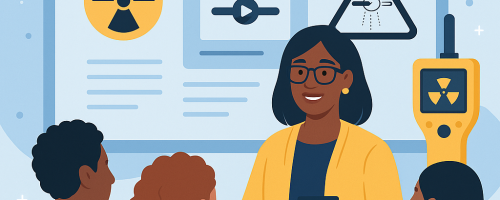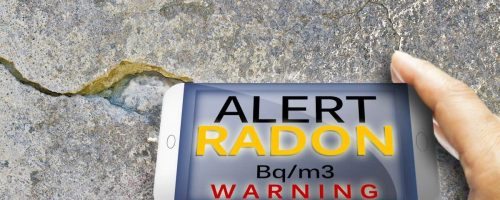Guest Author: Dr. Neil Alexander, Bucephalus Consulting
In everyday conversation the words hazard, danger, risk, and fear are used loosely, often interchangeably and in many cases incorrectly. Correctly defining and using these words can help achieve a better understanding of the issues surrounding radiation and nuclear power.
Hazard describes something that could, in theory, cause harm. Danger on the other hand arises when there is a mechanism for the hazard to actually cause harm. Something can be very hazardous but made safe with simple engineered protections. Electricity is a hazard, but we can use it safely in our homes by using insulation.
Risk combines the likelihood that a danger could cause harm with the significance of the harm it might cause. Risks are difficult to compare because some may have significant consequences but be very unlikely, while others may occur regularly but not cause much harm. Although they share a common metric our brains are not designed to make such comparisons and are not very effective at doing so, especially at the extremes.
Fear is an emotional response to the perception of the risk, and it may or may not be rational.
A trip to the CN Tower by someone like me who is afraid of heights, highlights many of these issues. Height is a hazard, but if you are in a glassed enclosure and cannot fall, that hazard is not easily converted into a danger. The CN Tower is considered safe, and the evidence shows that it is. There is still a risk, that the tower might collapse, but it is small. However, my fear of heights still prevented me from standing on the glass plate in the floor and looking down to the ground below.
Communications about nuclear issues are prone to similar challenges.
Radiation is a very weak cause of cancer, and it is generally easy to shield against radiation or contain radioactive materials. It is a hazard but not a great danger or a great risk. But people fear cancer and by implication anything associated with it. It is an emotional response to the idea of radiation not its actual effect.
The presentation of facts is often not enough to overcome fear. I knew that the glass plate was safe so someone providing me facts to prove it was safe would be wasting their time.
And sometimes knowledgeable people can inadvertently cause people to become more fearful when they present facts that mean one thing to them but could mean something else to their audience. I use an example of when, as a young metallurgist, I noticed a crack in the wing of a plane I was flying in. It had a neatly drilled hole at each end, a standard practice for stabilizing the cracks and making them safe. This told me that the plane had been inspected and was being well looked after. I felt safe. The gentleman next to me, who had never flown before because he was afraid of flying, had a different interpretation of this information when I pointed the crack out to him.
People laugh at my stupidity but then they typically realize that they have recently done something very similar. I once sat and listened to someone from the nuclear industry try to convince someone that nuclear was safe though a discussion about core damage frequencies!
In dealing with nuclear issues the situation is exacerbated by the poor, or perhaps deliberately deceptive way, people against nuclear will harness word confusions to amplify the fears.
There can be no doubt that used nuclear fuel is a hazardous material, as it contains some very nasty toxins and for a significant period emits dangerous quantities of ionizing radiation. But used fuel is primarily a solid (there are some very small quantities of volatile material because of the transmutations, but the vast majority is solid) and as a result it is easy to contain, manage, and shield. In the very unlikely everything did go wrong the consequence would be localized. It is a hazard but not a great danger, and the risk both of likelihood and magnitude are vanishingly small. This fact is borne out by the statistic that in over 70 years of used fuel production no one has been harmed by its storage, and it has done no environmental damage. And yet people fear used nuclear fuel.
On the other hand X-rays are something people accept and do not fear and yet, while their hazard is much lower, there are pathways whereby someone could suffer harm from X-rays, and harm is sometimes done.
As few people understand the important difference between hazard and danger, any reference to hazard, although meaningless, will imply danger and sometimes people deliberately conflate the two to trick people into being fearful. Simply pointing out the way this trick is played can help alleviate fear caused by this misconception.
Other misconceptions gain strength from similar word confusions.
You will often hear people say that “any bit of radiation can kill you”. This is sort of true as cancer is a statistical disease, and it may have been caused by a bit of “radiation”. Arguing that this is not true is fraught with danger but pointing out that using the same logic pretty much any bit of anything might kill you illuminates the trick and allows people to see it. I tell people any hug may give you a virus that causes cancer, any sausage may contain the nitrate molecule that initiates a cancer, or any banana may kill you (though it is more likely that you might slip on its skin than you will be nailed by the radiation it emits).
Similarly, it is often said that there is no safe level of radiation, the implication being that as any bit of radiation can kill you there is no level of radiation at which you are not at risk, or in other words, are not safe. The typical nuclear industry response to this claim is to point at background radiation but that rarely has the desired effect as it does not address the issue of what is safe and what is not. I have taken to asking people whether they sleep in a lead coffin or whether they feel it is safe not to. When they confirm that they do not sleep in a coffin and that does not make them feel unsafe I point out that they, not me, must consider background radiation to be safe and that as background radiation varies wildly, they not only consider their current level of radiation to be safe, but they also consider much higher radiation fields to be safe as well. If the discussion changes to ingestion I ask whether they always make sure they avoid Brazilian Brazil nuts (they have 1,000 times more radiation than most other foods including Brazil nuts form other countries). If they don’t, they clearly think ingesting certain quantities of radioactive materials is safe as well.
It appears that pointing out the facts alone does not achieve much but showing how language may have led people to the wrong conclusion does seem to help them see the truth through the conflations and confusions.
It was when someone acknowledged my fear of heights and pointed out that it was this fear, and not any real risk, that was causing my concern, that I was able to get on the plate and “enjoy” the view of the ground below.
Communications about nuclear issues and radioactivity have suffered as a result of allowing these misconceptions to be repeated to the point where that repetition has made them into the truth.
We may never get people to stop fearing cancer, and we shouldn’t try, but by using words precisely and pointing out how the misconceptions arise we may stop appropriate fears from affecting people’s judgement. As I write this and expose to myself how irrational my fear of the CN Tower is, I think I may be able to give it one more try. I will still fear heights, but I may be able to get my rational brain to manage that fear.
Ironically, while the nuclear industry is seen as being a major cause of cancer, it rarely is. But what it does do is diagnose and treat cancer, saving millions of people from suffering and/or and early death, but it rarely gets credited with this very valuable contribution.
See our May 12, 2025 webinar on this topic featuring Dr. Alexander here: https://radiationsafety.ca/services/webinars/, or get a certificate for viewing here: https://onlinelearning.radiationsafety.ca/course/view.php?id=208. You will need to create an account if you do not already have one.







